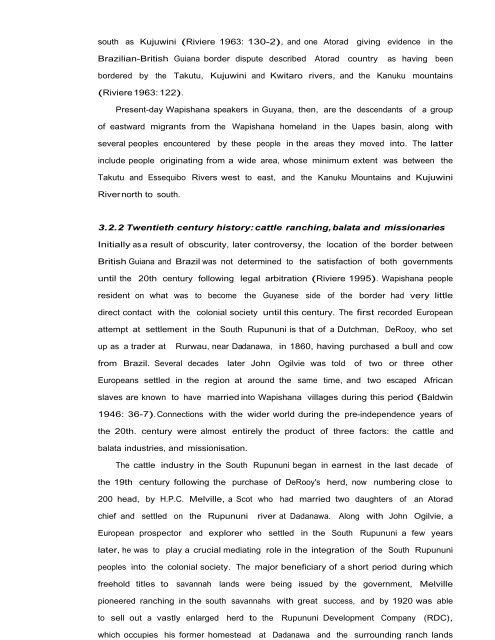Ethnoecology, Resource Use, Conservation And Development In A ...
Ethnoecology, Resource Use, Conservation And Development In A ...
Ethnoecology, Resource Use, Conservation And Development In A ...
Create successful ePaper yourself
Turn your PDF publications into a flip-book with our unique Google optimized e-Paper software.
south as Kujuwini (Riviere 1963: 130-2), and one Atorad giving evidence in the<br />
Brazilian-British Guiana border dispute described Atorad country as having been<br />
bordered by the Takutu, Kujuwini and Kwitaro rivers, and the Kanuku mountains<br />
(Riviere 1963: 122).<br />
Present-day Wapishana speakers in Guyana, then, are the descendants of a group<br />
of eastward migrants from the Wapishana homeland in the Uapes basin, along with<br />
several peoples encountered by these people in the areas they moved into. The latter<br />
include people originating from a wide area, whose minimum extent was between the<br />
Takutu and Essequibo Rivers west to east, and the Kanuku Mountains and Kujuwini<br />
River north to south.<br />
3.2.2 Twentieth century history: cattle ranching, balata and missionaries<br />
<strong>In</strong>itially as a result of obscurity, later controversy, the location of the border between<br />
British Guiana and Brazil was not determined to the satisfaction of both governments<br />
until the 20th century following legal arbitration (Riviere 1995). Wapishana people<br />
resident on what was to become the Guyanese side of the border had very little<br />
direct contact with the colonial society until this century. The first recorded European<br />
attempt at settlement in the South Rupununi is that of a Dutchman, DeRooy, who set<br />
up as a trader at Rurwau, near Dadanawa, in 1860, having purchased a bull and cow<br />
from Brazil. Several decades later John Ogilvie was told of two or three other<br />
Europeans settled in the region at around the same time, and two escaped African<br />
slaves are known to have married into Wapishana villages during this period (Baldwin<br />
1946: 36-7). Connections with the wider world during the pre-independence years of<br />
the 20th. century were almost entirely the product of three factors: the cattle and<br />
balata industries, and missionisation.<br />
The cattle industry in the South Rupununi began in earnest in the last decade of<br />
the 19th century following the purchase of DeRooy's herd, now numbering close to<br />
200 head, by H.P.C. Melville, a Scot who had married two daughters of an Atorad<br />
chief and settled on the Rupununi river at Dadanawa. Along with John Ogilvie, a<br />
European prospector and explorer who settled in the South Rupununi a few years<br />
later, he was to play a crucial mediating role in the integration of the South Rupununi<br />
peoples into the colonial society. The major beneficiary of a short period during which<br />
freehold titles to savannah lands were being issued by the government, Melville<br />
pioneered ranching in the south savannahs with great success, and by 1920 was able<br />
to sell out a vastly enlarged herd to the Rupununi <strong>Development</strong> Company (RDC),<br />
which occupies his former homestead at Dadanawa and the surrounding ranch lands


